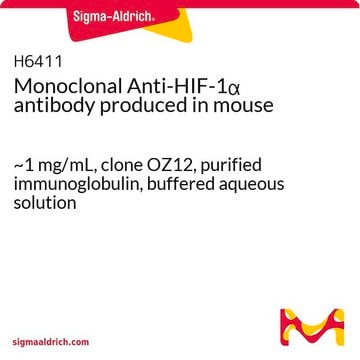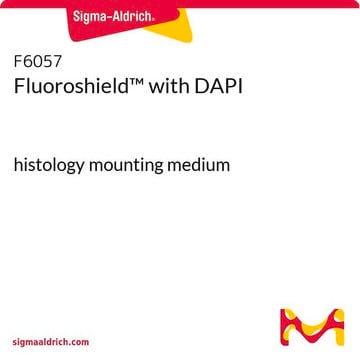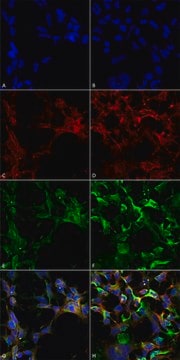H6536
Monoclonal Anti-HIF-1α antibody produced in mouse
~1 mg/mL, clone H1α67, purified immunoglobulin, buffered aqueous solution
Sinônimo(s):
Anti-Hypoxia Inducible Factor 1, α subunit
About This Item
Produtos recomendados
fonte biológica
mouse
Nível de qualidade
conjugado
unconjugated
forma do anticorpo
purified immunoglobulin
tipo de produto de anticorpo
primary antibodies
clone
H1α67, monoclonal
Formulário
buffered aqueous solution
peso molecular
antigen 120 kDa
reatividade de espécies
rat, sheep, ferret, human, mouse
concentração
~1 mg/mL
técnica(s)
immunohistochemistry (formalin-fixed, paraffin-embedded sections): 1:500-1:1,000 using antigen retrieval
immunoprecipitation (IP): suitable
western blot: 1:500-1:1,000
Isotipo
IgG2b
nº de adesão UniProt
Condições de expedição
wet ice
temperatura de armazenamento
−20°C
modificação pós-traducional do alvo
unmodified
Informações sobre genes
human ... HIF1A(3091)
mouse ... Hif1a(15251)
rat ... Hif1a(29560)
Descrição geral
Imunogênio
Aplicação
Immunohistochemistry (1 paper)
forma física
Exoneração de responsabilidade
Não está encontrando o produto certo?
Experimente o nosso Ferramenta de seleção de produtos.
Código de classe de armazenamento
10 - Combustible liquids
Classe de risco de água (WGK)
nwg
Ponto de fulgor (°F)
Not applicable
Ponto de fulgor (°C)
Not applicable
Escolha uma das versões mais recentes:
Já possui este produto?
Encontre a documentação dos produtos que você adquiriu recentemente na biblioteca de documentos.
Os clientes também visualizaram
Nossa equipe de cientistas tem experiência em todas as áreas de pesquisa, incluindo Life Sciences, ciência de materiais, síntese química, cromatografia, química analítica e muitas outras.
Entre em contato com a assistência técnica










